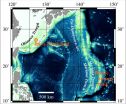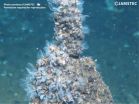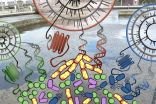Hydrothermal settlers
2014-11-26
(Press-News.org) This news release is available in Japanese.
The deep ocean seems so remote that it is difficult to imagine any sort of human-generated change making an impact on deep-sea life. It is even more difficult to collect or examine evidence from the deep ocean to determine what those impacts might be. Enter the barnacle; a hard, sessile creature that looks like a tiny volcano and attaches to rocks, boat bottoms, and other hard substrates, where it filters ocean water to feed on tiny organisms. The barnacle holds clues about how climate change is affecting the deep ocean. Okinawa Institute of Science and Technology Graduate University Marine Biophysics Unit researcher Yuichi Nakajima recently studied two kinds of deep-sea barnacle in a collaboration with the Marine Genomics Unit and the Japan Agency for Marine-Earth Science and Technology (JAMSTEC). He identified genetic data that suggest the diversity and differentiation of barnacle populations in two deep-sea troughs near Okinawa and the Mariana Islands, and his findings have been published in the International Journal of Molecular Sciences.
Barnacles make very convenient study subjects because they are portable, well-protected, and relatively easy subjects for DNA extraction and sequencing. For this experiment, Nakajima studied two species of deep-sea barnacle called Neoverruca sp.1 and Neoverruca brachylepadoformis. He received his samples from a JAMSTEC voyage that collected specimens using a remote operated vehicle about 1000 and 3600 meters below sea level in the Okinawa and Mariana troughs, respectively. Nakajima then extracted DNA from the barnacles and sequenced it with Marine Genomics Unit members, noting differences in the genetic code known as polymorphisms. Where one barnacle might have a repeat pattern in the long sequence of nucleic acids, another might have a different repeat pattern. He grouped the segments by polymorphism, and identified 12 distinct segments called microsatellites. Each of these segments with its unique code can be used as genetic markers, high-resolution sequences that allow researchers to examine nearly unnoticeable differences in genetic code that separate two species.
Identifying microsatellite markers is important because microsatellites show how genes are passed and inherited within a population. Analyzing this genetic data can show the genetic diversity of the population, which researchers can use to draw conclusions about the health of the population. "Genetic diversity is an index of extinction and of population size," explained Nakajima. "Higher genetic diversity means a healthy population, but decreasing genetic diversity means that the population kinship increases." Kinship refers to mating systems and interactions within a population; behaviors that spread genes from one individual to another. The increase in kinship means that individuals in smaller populations share a larger proportion of their genes than in larger populations, lowering the population's genetic diversity. "Genetic diversity is necessary for population maintenance," said Nakajima.
In addition, microsatellites can also show whether other populations are migrating to the area by showing the origin of new genes introduced to the population. This would help explain the genetic connectivity, or shared genes, between barnacle species in the two troughs, separated by more than a thousand kilometers of ocean where these barnacles cannot survive. Or at least, the barnacles cannot survive there as settled adults. In their young, larval phase, the barnacles float on the ocean current and can migrate to other troughs, introducing their genes to other populations. Knowing barnacle migration patterns will reveal the movement of the currents in the northwestern Pacific.
In addition to showing how currents move and species are connected, understanding the genetic diversity of a species or population allows researchers to predict that species' risk of extinction. "We are worried that deep ocean species will go extinct," said Nakajima. Using the barnacle as a model organism, Nakajima can extrapolate how other species may be faring and how the deep-sea ecosystem is changing, thereby predicting the consequences before species go extinct.
"We know that the ocean's surface will be affected by climate change," said Nakajima, acknowledging that for a long time, researchers were not sure whether these effects would reach the deep ocean. In addition to altering ocean currents climate change seems to affect marine snow, a phenomenon where clusters of organic material aggregate in the ocean to look like fluffy snowflakes, then fall to the ocean floor. Marine snow provides food for deep ocean scavengers, but many marine scientists, including Nakajima, are worried that climate change will alter the amount of marine snow that sinks through the ocean. "Recent studies reported that the deep sea will also be influenced by surface disturbances." Nakajima's barnacles offer a necessary window, through which he can examine how the greatest environmental crisis of our time will change one of the most mysterious parts of the world.
INFORMATION:
ELSE PRESS RELEASES FROM THIS DATE:
2014-11-26
KNOXVILLE - Warfare not only hastened human technological progress and vast social and political changes, but may have greatly contributed to the evolutionary emergence of humans' high intelligence and ability to work together toward common goals, according to a new study from the National Institute for Mathematical and Biological Synthesis (NIMBioS).
How humans evolved high intelligence, required for complex collaborative activities, despite the various costs of having a big brain has long puzzled evolutionary biologists. While the human brain represents only about two ...
2014-11-26
Published in the journal Nature, the discovery could revolutionise fuel cells and other hydrogen-based technologies as they require a barrier that only allow protons - hydrogen atoms stripped off their electrons - to pass through.
In addition, graphene membranes could be used to sieve hydrogen gas out of the atmosphere, where it is present in minute quantities, creating the possibility of electric generators powered by air.
One-atom thick material graphene, first isolated and explored in 2004 by a team at The University of Manchester, is renowned for its barrier properties, ...
2014-11-26
NGC 3532 is a bright open cluster located some 1300 light-years away in the constellation of Carina(The Keel of the ship Argo). It is informally known as the Wishing Well Cluster, as it resembles scattered silver coins which have been dropped into a well. It is also referred to as the Football Cluster, although how appropriate this is depends on which side of the Atlantic you live. It acquired the name because of its oval shape, which citizens of rugby-playing nations might see as resembling a rugby ball.
This very bright star cluster is easily seen with the naked eye ...
2014-11-26
Jülich, 26 November 2014 - In metals such as copper or aluminium, so-called conduction electrons are able to move around freely, in the same way as particles in a gas or a liquid. If, however, impurities are implanted into the metal's crystal lattice, the electrons cluster together in a uniform pattern around the point of interference, resembling the ripples that occur when a stone is thrown into a pool of water. Scientists in Jülich have, with the help of computer simulations, now discovered a combination of materials that strengthens these Friedel oscillations ...
2014-11-26
The Luxembourg Centre for Systems Biomedicine (LCSB) has succeeded for the first time in describing the complex relationships within an ecosystem in unprecedented detail. For their work, carried out in collaboration with US and Luxembourg partners, their model ecosystem was a "biological wastewater treatment plant". In it live numerous species of bacteria which are involved in the wastewater purification process.
LCSB director Prof. Dr. Rudi Balling stresses the medical importance of these research efforts: "Bacterial ecosystems also play a major role in our health. ...
2014-11-26
Although the van der Waals force was discovered around 150 years ago, it is still difficult to quantify when predicting the behaviour of solids, liquids, and molecules. Precise measurements were only possible up to now for single atoms or macroscopic objects. However, the van der Waals forces are particularly important at intermediate size, where they crucially co-determine the behaviour of complex molecules, such as biomolecules and proteins. They are also responsible for the functioning of certain adhesives and are the reason why geckos can adhere so amazingly well to ...
2014-11-26
This news release is available in French. The way people with autism spectrum disorder (ASD) gather information - not the judgement process itself - might explain why they gain different perceptions from peoples' faces, according to a new study from Hôpital Rivière-des-Prairies and the University of Montreal. "The evaluation of an individual's face is a rapid process that influences our future relationship with the individual," said Baudouin Forgeot d'Arc, lead author of the study. "By studying these judgments, we wanted to better understand how people with ...
2014-11-26
The precise movements of a young hammerhead shark have been tracked for the first time and are published in the open access journal Animal Biotelemetry. The study, which ran over a 10-month period, reveals important gaps in current efforts to protect these endangered sharks and suggests key locations that should be protected to help the survival of the species.
Hammerhead sharks, which have recently received new protections from the UN Convention on the Conservation of Migratory Species of Wild Animals, are experiencing drastic population declines in excess of 90% in ...
2014-11-26
The expression of a gene involved in female birds' color vision is linked to the evolution of colorful plumage in males, reports a new study from the University of Chicago. The findings, published Nov. 26 in the Proceedings of the Royal Society B, confirm the essential role of female color perception in mate selection and sexual dimorphism.
"This is the first time an aspect of the visual system in birds has been directly associated with plumage evolution," said Natasha Bloch, PhD, who authored the study while a graduate student in ecology & evolution at the University ...
2014-11-26
Deaf teenagers have better reading skills if they were identified as deaf by the time they were nine months old, research from the University of Southampton has shown.
The Southampton team has been studying the development of a group of children who were identified with permanent childhood hearing impairment (PCHI) at a very early age in a pilot screening programme conducted in Southampton and London in the 1990s.
Follow up assessments when the children were aged eight showed those who were screened at birth had better language skills than those children who were not ...
LAST 30 PRESS RELEASES:
[Press-News.org] Hydrothermal settlers







